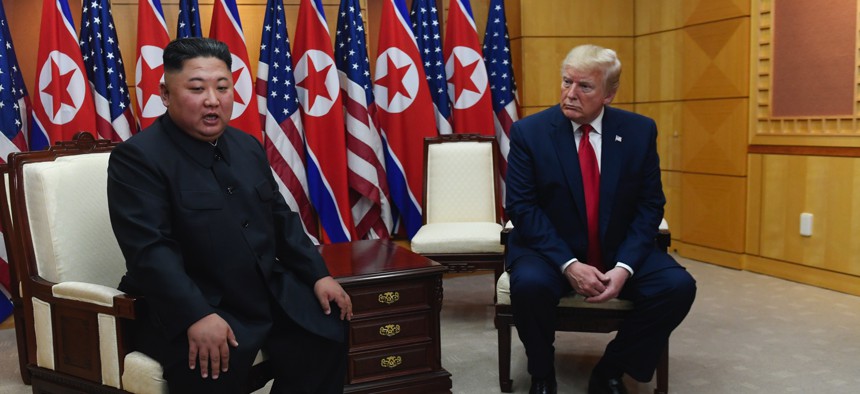
President Donald Trump meets with North Korean leader Kim Jong Un at the border village of Panmunjom in the Demilitarized Zone, South Korea, Sunday, June 30, 2019. AP / Susan Walsh
How North Korea Soured on Donald Trump
Kim Jong Un only wanted to engage with the president. Now he’s turning on him.
The part where Donald Trump described Joe Biden as a step above a “rabid dog” got all the attention, but the president’s tweet to Kim Jong Un earlier this month had another significant message: Better seize the day, because tomorrow could bring a President Biden. “I am the only one who can get you where you have to be,” Trump wrote. “You should act quickly, get the deal done. See you soon!”
The tweet was part of a sales pitch to Pyongyang that I’ve heard from other Trump-administration officials. It goes something like this: The 2016 U.S. election produced a historic aberration that North Korea should avail itself of: an American leader unburdened by the policy and diplomatic conventions that inhibited his predecessors from resolving 70 years of hostilities with the Kim regime; a transactional dealmaker with a vision of a prosperous, condo- and hotel-dotted, nuclear-weapons-free North Korea; a man perfectly willing to meet with North Korea’s dictator, exchange love letters with him, even revel in their mutual hatred of Joe Biden.
As Stephen Biegun, the State Department’s special representative for North Korea, warned last week, the window for this once-in-a-generation opportunity to reach a nuclear agreement may not remain open for long.
So why, as Biegun himself emphasized during congressional testimony, is North Korea barely engaging in nuclear talks with the United States at the moment, even as the 2020 election approaches with no guarantee Trump will win again? Why is Kim standing by as the Trump Window potentially closes—and actually hastening the closure by giving the U.S. a year-end deadline to adopt a more flexible negotiating position or put at risk nearly two years of diplomacy between the countries?
Related: On North Korea, the Chickens Are Coming Home to Roost
Related: How Long Can Trump Keep Ignoring Kim’s Missile Tests?
Related: Esper, Milley Push South Korea to Pay More for US Troop Protection
In recent weeks, in fact, the North Koreans have thrown all sorts of wrenches into the (albeit already gummed-up) diplomatic works, even as Trump has dangled another leader-level summit before Kim and as his administration has made other conciliatory gestures, such as postponing military exercises with South Korea.
North Korean negotiators walked away in a huff from a meeting last month in Sweden with Biegun and his team without seriously discussing denuclearization or consenting to follow-up talks. In a remarkable flurry of statements for a government that typically tightly controls its communications, North Korean officials rejected the idea of another meeting with the American president (something the Kim regime coveted only a couple of years ago) and ruled outfurther denuclearization talks until the United States ends its “hostile policy” toward their country, including U.S.–South Korea military drills and international economic sanctions.
The Kim regime “now considers summits without payment for cooperation as empty diplomacy that merely helps ... Trump raise domestic political support,” Leif-Eric Easley, a Korea expert at Ewha Womans University, in Seoul, told me. It’s ironically the mirror-image argument to what Trump’s critics contended when he became the first American president to meet with North Korea’s dictator: that it would grant Kim valuable legitimacy while leaving the United States with nothing of substance to show for it.
Apparently emboldened, this week alone Kim has twice spurned South Korea by declining an invitation to attend a regional conference and by violating a military agreement with its neighbor, making it harder for the South Korean government to do what it has done repeatedly over the past two years: act as a catalyst for diplomacy between the U.S. and North Korea. Kim has also conducted a series of tests of nuclear-capable ballistic missiles since the spring. The not-so-subtle subtext of these provocations is that if the Trump administration doesn’t change its policies to his satisfaction by the new year, Kim could resume the tests of nuclear bombs and long-range missiles that brought the United States and North Korea to the brink of war in 2017.
With six weeks to go until the end of 2019, Biegun told lawmakers that Kim has not yet empowered his negotiators to discuss the country’s nuclear-weapons program with their American counterparts, nor agreed in writing on a suspension of nuclear and missile tests, a definition of denuclearization, or how North Korea would undertake such a process. Instead, he acknowledged that North Korea has continued advancing its nuclear arsenal by, for instance, producing more fissile material. When asked by Senator Cory Gardner whether he believed the United States is closer today to the denuclearization of North Korea than it was after the first Trump-Kim summit, in Singapore 17 months ago, Biegun sighed heavily. “I do,” he said gingerly, but “in all candor there is no meaningful or verifiable evidence that North Korea has yet made the choice to denuclearize.”
Biegun’s presence at the hearing was itself a troubling sign for the negotiations. He was there because Trump has nominated him to be Mike Pompeo’s second in command at the State Department, in addition to serving as his North Korea envoy. Biegun insisted that the promotion would enhance his stature with the Kim regime and make nuclear talks even more of a priority for the administration, but it could also signal that he is moving on from a fruitless posting that won’t be occupying much of his time in the future. After all, Pompeo and Trump, officials of the highest stature, have also negotiated with the North Koreans. And yet here we are.
One theory of what North Korea’s leaders are up to is that they do appreciate the unique opportunity the Trump presidency represents, and are simply trying to milk it to maximum effect by escalating pressure. With the departure of John Bolton, the president’s hawkish national security adviser; the U.S.–South Korea alliance plagued by a military-cost-sharing dispute; and the impeachment-saddled Trump thirsty for foreign-policy wins as he campaigns for reelection, Kim may see an opening to obtain an interim deal. For instance, the United States might trade substantial sanctions relief and an end to its military exercises with South Korea for a rollback of North Korea’s nuclear-weapons program that falls somewhere short of full denuclearization.
The main holdup in negotiations has been the Trump administration’s unwillingness to ease sanctions on North Korea, even if only partially and in a reversible manner, until North Korea commits to complete denuclearization, so “if Trump makes a decision to loosen some sanctions I think we could see this roll into a deal pretty quickly,” Victor Cha, a Korea expert at the Center for Strategic and International Studies and onetime candidate to be Trump’s ambassador to South Korea, told me.
Thae Yong Ho, a former North Korean diplomat and one of the highest-ranking officials ever to defect from the country, told me Kim has been indicating to the president “that he will continue the friendship, but in the meanwhile he has the means to destroy President Trump’s dream to be reelected by resuming” nuclear and missile tests.
But there is another (not necessarily mutually exclusive) theory of what’s behind the Kim government’s behavior in recent months: It already tried to strike while the iron was hot, only to discover that the iron wasn’t as hot as it anticipated. During the second Trump-Kim summit, in Vietnam, Kim proposed that the Trump administration lift most sanctions in exchange for the dismantlement of North Korea’s main nuclear facility. The Americans refused to settle for partial denuclearization, and so the North Koreans may no longer have much interest in concluding an agreement with Trump—at least until they have more certainty about who will be the next president.
When I asked Thae, who sought refuge in South Korea in 2016, about the argument that Kim would be wise to not miss his shot at a nuclear agreement with Trump before a more conventional American president like Biden assumes office, he responded that he thought this premise was “really wrong.” North Korea’s leaders believe that the United States lost some time ago the opportunity to denuclearize North Korea, which now has dozens of nuclear weapons and has nearly developed the capability, if it doesn’t possess it already, to strike the United States and the rest of the world with nuclear-tipped missiles. That makes the many differences between a summitteering pen-pal president and a “rabid dog” rather immaterial. Officials in Pyongyang “understand that the policy of the current [U.S.] government, and the future government as well,” will in effect “be a kind of risk management rather than denuclearization,” Thae said.
The North Koreans “clearly believe that Trump wants [a deal] more than they do,” Cha noted, in reference to why they may not view the Trump era as the golden moment the U.S. has portrayed. They “don’t really care,” because “they want to keep their weapons” rather than relinquish them for what’s currently on offer from Trump, and “if they can get something else for giving up pieces of the program they no longer need, that’s fine.”
In defending the president’s approach, Biegun argued that with each successive U.S. administration and each passing day, the policy options for addressing Pyongyang’s growing nuclear threat are narrower, adding that either accepting Kim’s arsenal or abandoning efforts to reverse it would amount to ensuring that North Korea becomes a permanent nuclear-weapons state. But the reality is that North Korea may cement its status as a nuclear state in the coming months even if the Trump administration persists with its efforts.
As the North Korea scholar Robert Carlin recently wrote, “If Pyongyang has decided it has a viable option to move to full and final development of its most fearsome weapons while the U.S. sinks into months of savage internal political warfare, then East Asia, in fact the entire Western Pacific, will in a flash become more dangerous than it has been at any time since World War II.”




